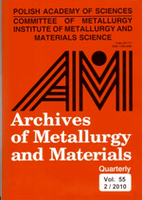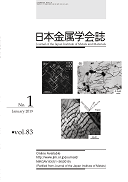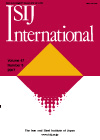
METALLURGIST
Scope & Guideline
Advancing Metallurgy, Shaping the Future of Materials Science.
Introduction
Aims and Scopes
- Metallurgical Processes and Techniques:
The journal covers a wide range of metallurgical processes including welding, casting, rolling, and surface treatment techniques. It emphasizes the development of new methods and the optimization of existing processes to improve efficiency and product quality. - Material Science and Alloy Development:
Research on the properties, microstructures, and behaviors of various alloys is a core focus. Papers often explore how different compositions and processing conditions affect the performance of metals and alloys in practical applications. - Recycling and Waste Management:
A significant portion of the journal's content addresses the recycling of metallurgical by-products and waste materials, highlighting sustainable practices that reduce environmental impact and promote resource recovery. - Advanced Manufacturing Technologies:
The journal emphasizes the role of advanced manufacturing techniques such as additive manufacturing, laser processing, and other innovative approaches that enhance production capabilities and material properties. - Computational and Modeling Approaches:
Papers often incorporate computational modeling and simulations to understand and predict material behaviors and process outcomes, thus aiding in the design and optimization of metallurgical processes.
Trending and Emerging
- Additive Manufacturing and 3D Printing:
There is a significant increase in research related to additive manufacturing, including studies on the properties and applications of materials produced through 3D printing techniques. This trend is driven by the demand for customized components and complex geometries. - Sustainability and Green Metallurgy:
Papers focusing on sustainable practices, including recycling processes and the reduction of carbon footprints in metallurgical operations, are gaining traction. This reflects a broader industry shift towards environmental responsibility. - Artificial Intelligence and Machine Learning Applications:
The integration of AI and machine learning into metallurgical processes is emerging as a significant theme. Research is increasingly exploring how these technologies can optimize manufacturing processes and improve material properties. - Nanotechnology in Metallurgy:
The application of nanotechnology to enhance the properties of metals and alloys is a growing area of interest. Research in this area focuses on how nanoscale modifications can lead to improved performance in various applications. - Digital Twins and Smart Manufacturing:
The use of digital twins and smart manufacturing technologies is on the rise, with research exploring how these innovations can improve process monitoring, control, and optimization in metallurgical operations.
Declining or Waning
- Traditional Metallurgical Techniques:
There has been a noticeable decrease in publications focusing solely on traditional metallurgical methods without integration of new technologies or materials. The shift towards advanced manufacturing and digital technologies has overshadowed basic research in conventional practices. - Thermodynamic Studies:
Although thermodynamics remains a fundamental aspect of metallurgy, the frequency of papers dedicated solely to thermodynamic modeling has diminished, as researchers increasingly integrate these principles with practical applications and advanced simulations. - Basic Alloy Composition Studies:
Research that solely examines the basic composition of alloys without considering processing conditions or applications is becoming less frequent. The trend is moving towards more applied research that connects alloy composition with real-world performance.
Similar Journals

METALLURGICAL AND MATERIALS TRANSACTIONS B-PROCESS METALLURGY AND MATERIALS PROCESSING SCIENCE
Pioneering Research in the Heart of Materials ProcessingMETALLURGICAL AND MATERIALS TRANSACTIONS B-PROCESS METALLURGY AND MATERIALS PROCESSING SCIENCE, published by Springer, serves as a pivotal platform in advancing the field of materials science, focusing specifically on the intricacies of process metallurgy and materials processing. With an ISSN of 1073-5615 and an E-ISSN of 1543-1916, this esteemed journal boasts an impressive standing with its 2023 category quartiles, ranking Q2 in Condensed Matter Physics, Materials Chemistry, and Mechanics of Materials, while achieving a top-tier Q1 classification in Metals and Alloys. Positioned in the United States, the journal has been publishing leading research since its inception, with converged years spanning from 1973 to 1979 and 1995 to 2024. The journal's robust impact within its fields is reflected in its Scopus rankings, notably ranking #42 out of 176 in Materials Science with a 76th percentile. Though not an open access journal, its comprehensive and high-quality research articles cater to the needs of researchers, professionals, and students, ensuring they remain at the forefront of advancements in metallurgy and materials processing science.

METALLURGICAL AND MATERIALS TRANSACTIONS A-PHYSICAL METALLURGY AND MATERIALS SCIENCE
Bridging Theory and Application in Metallurgical ResearchMETALLURGICAL AND MATERIALS TRANSACTIONS A - PHYSICAL METALLURGY AND MATERIALS SCIENCE, published by Springer, is a prestigious journal that plays a pivotal role in advancing the fields of physical metallurgy and materials science. With an ISSN of 1073-5623 and an E-ISSN of 1543-1940, this American journal provides a vital platform for disseminating cutting-edge research and innovative findings relevant to condensed matter physics, mechanics of materials, and metals and alloys. The journal, indexed with an impressive Q1 ranking in multiple categories in 2023, ensures its position among the top-tier publications, making it an essential resource for researchers, professionals, and students alike. Spanning decades of invaluable contributions since its inception in 1975, METALLURGICAL AND MATERIALS TRANSACTIONS A focuses on fostering academic dialogue, promoting collaboration, and showcasing leading-edge discoveries that drive the materials science community forward. Researchers seeking to publish their work in a highly visible forum will find this journal an optimal choice for reaching a discerning audience.

Mineral Processing and Extractive Metallurgy-Transactions of the Institutions of Mining and Metallurgy
Exploring Innovations in Extractive MetallurgyMineral Processing and Extractive Metallurgy - Transactions of the Institutions of Mining and Metallurgy is a premier journal published by SAGE Publications Inc that aims to provide a dynamic platform for researchers, professionals, and students in the fields of mineral processing, extractive metallurgy, and related disciplines. With an ISSN of 2572-6641 and E-ISSN 2572-665X, this journal spans a diverse range of topics including geochemistry, geotechnical engineering, and the latest advancements in mining technologies. Currently classified in the Q3 quartile across various categories, it holds commendable rankings in Earth and Planetary Sciences and is recognized for its impactful contributions to the science of resource extraction. The journal accepts contributions from both theoretical and applied perspectives, fostering a multidisciplinary approach to mineral resource utilization. Researchers can access cutting-edge studies that break new ground in extraction techniques and processing innovations, enhancing the sustainability of mining operations. Since its inception in 2018, it has consistently attracted a global readership, making it an essential resource for those dedicated to advancing the fields of geology and metallurgy.

Archives of Foundry Engineering
Empowering Researchers with Open Access to Cutting-Edge FindingsArchives of Foundry Engineering is a peer-reviewed, open-access journal published by POLSKA AKAD NAUK, POLISH ACAD SCIENCES, dedicated to advancing knowledge in the field of Industrial and Manufacturing Engineering as well as Metals and Alloys. With its ISSN number 1897-3310 and E-ISSN 2299-2944, this journal has been committed to fostering innovation and research since its inception in 2012. As of 2023, it proudly holds a Q3 ranking in both relevant categories, indicating its growing influence in the scientific community, with Scopus rankings reflecting its emerging prominence in the materials science arena. Archives of Foundry Engineering has transitioned to open access since 2022, ensuring that researchers, professionals, and students have free and unrestricted access to high-quality research. By disseminating cutting-edge findings and facilitating dialogue among scholars, the journal serves as a crucial platform for advancing the discipline and supporting academic and industrial advancements.

ARCHIVES OF METALLURGY AND MATERIALS
Shaping the Future of Metals and Alloys ResearchArchives of Metallurgy and Materials is a prestigious open-access journal published by the Polish Academy of Sciences, Institute of Metallurgy and Materials Science. With its ISSN 1733-3490 and E-ISSN 2300-1909, this journal has been a critical resource for researchers and professionals in the field of materials science since its establishment in 2004. The journal focuses primarily on advancements in metals and alloys, contributing to the growing body of knowledge in this dynamic and evolving discipline. As acknowledged in the 2023 Scopus rankings, it currently holds a Q3 category in both Metals and Alloys with a rank of #117 out of 176 journals, indicating its commitment to quality research despite being relatively young in the indexing landscape. With its open-access policy initiated in 2010, the journal aims to enhance the dissemination of scientific findings and encourage collaboration among the global materials science community. Researchers, students, and industry professionals are invited to explore the valuable insights and innovations showcased within Archives of Metallurgy and Materials, contributing to the advancement of material technologies and applications.

Journal of the Japan Institute of Metals and Materials
Bridging science and application in materials technology.Journal of the Japan Institute of Metals and Materials (ISSN: 0021-4876, E-ISSN: 1880-6880) serves as a vital academic platform under the esteemed auspices of the Japan Institute of Metals & Materials. This journal, with a rich publication history dating back to 1937, focuses on advancing knowledge in the fields of metallurgy, materials science, and engineering, making it an important resource for researchers, professionals, and students alike. Although the journal has been categorized in Q4 quartiles across several subject areas, including Condensed Matter Physics and Materials Chemistry, it plays a critical role in disseminating essential findings and fostering discussion regarding innovations in metal and materials research. Notably, the journal operates without open access, which encourages targeted readership engagement through its curated content. Based in Japan, it continues to contribute significantly to the academic community by bridging the gap between scientific inquiry and practical application in materials technology.

Materiali in Tehnologije
Exploring the Frontiers of Material TechnologiesMateriali in Tehnologije is a distinguished peer-reviewed journal dedicated to the field of materials science, focusing specifically on metals and polymers. Published by the Institute for Metals and Materials Technology in Slovenia, this open-access journal has been at the forefront of disseminating research findings and innovative technologies since 2000. With a current impact factor that reflects its increasing visibility in the academic community, Materiali in Tehnologije serves as an invaluable resource for researchers, professionals, and students alike, encompassing a wide array of studies in the categories of Metals and Alloys, as well as Polymers and Plastics. The journal is indexed in Scopus, highlighting its relevance and contribution to the field, particularly with its ranks of Q3 in Metals and Alloys and Q4 in Polymers and Plastics. As it converges towards 2024, Materiali in Tehnologije continues to be a pivotal platform for knowledge exchange, encouraging advancements in materials research and technology.

RUSSIAN METALLURGY
Illuminating the Path of Metallurgical ExcellenceRUSSIAN METALLURGY is a distinguished journal published by PLEIADES PUBLISHING INC, focusing on the fields of metals and alloys. With an ISSN of 0036-0295 and an E-ISSN of 1555-6255, this journal serves as a vital resource for researchers and practitioners alike, offering insights into the latest advancements and innovative research within the metallurgy domain. Recognized in a competitive landscape, it holds a Q3 ranking in the Metals and Alloys category as of 2023, reflecting its commitment to rigorous scientific dissemination. The journal spans a significant historical timeline of research since its inception in 1984, with aims to advance the knowledge and application of metallurgical science. Although currently not open access, it remains crucial for those aiming to stay current in the dynamic field of materials science. RUSSIAN METALLURGY fosters a deeper understanding of the physical and chemical properties of metals, guiding future innovations in industry and academia.

Acta Metallurgica Sinica-English Letters
Innovating Industrial Engineering Through Rigorous Scholarship.Acta Metallurgica Sinica-English Letters, published by the Chinese Academy of Sciences, Institute of Metal Research, is a premier international journal that has been fostering the advancement of knowledge in the fields of Industrial and Manufacturing Engineering and Metals and Alloys since its inception in 1997. With a commendable impact factor and ranking within the top quartiles (Q1) of leading Scopus categories, this journal serves as a vital platform for researchers and professionals to disseminate innovative research findings and groundbreaking methodologies. Notably recognized with a Scopus rank of #34 out of 176 in Materials Science and rank #81 out of 384 in Engineering, it provides a robust space for high-quality, peer-reviewed articles, thus bridging the gap between theoretical advancement and practical application in metallurgy and materials science. Although currently not an open-access journal, its rigorous editorial standards and comprehensive scope ensure that only the most impactful research contributes to the scientific community and industry advancements globally. Acta Metallurgica Sinica-English Letters is an essential read for anyone eager to stay informed on cutting-edge developments within these crucial domains.

ISIJ INTERNATIONAL
Fostering Dialogue on Cutting-Edge Materials ResearchISIJ INTERNATIONAL is a distinguished open-access journal in the fields of Materials Chemistry, Mechanical Engineering, Mechanics of Materials, and Metals and Alloys, published by the esteemed IRON STEEL INST JAPAN KEIDANREN KAIKAN. Since its inception in 1986, ISIJ INTERNATIONAL has played a pivotal role in disseminating advanced research and critical findings in steel and iron industries, significantly contributing to innovations in materials science and engineering. With a commendable impact factor and categorized in Q2 quartiles across its relevant fields in 2023, the journal ranks favorably among other prestigious publications, evidencing its influence and relevance within the academic community. The journal promotes open access, allowing unrestricted online access to its published work since 2012, thus ensuring that researchers, professionals, and students can readily access cutting-edge research. The journal's comprehensive scope empowers researchers to connect over pioneering studies and methodologies that address contemporary challenges in materials and engineering domains, thereby fostering a rich dialogue and knowledge exchange.